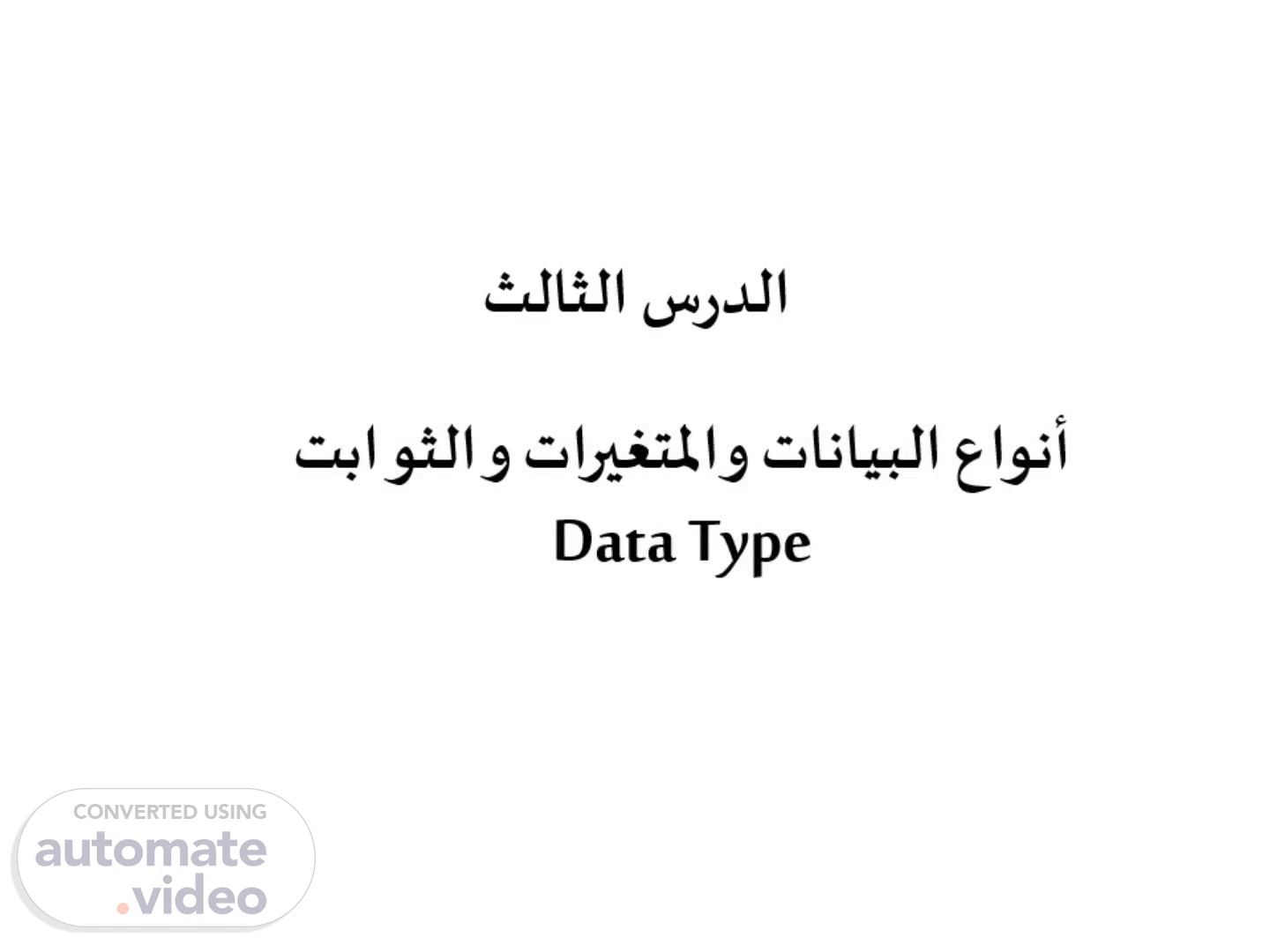Scene 1 (0s)
[Audio] أهلا وسهلا بكم في الدرس الثالث من دورة تدريبية حول أنواع البيانات والمتغيرات والثوابت. سوف نلقي نظرة خلال هذا الدرس على تعريف البيانات وأهميتها في المجال الحاسوبي، وكذلك سنتعرف على مختلف أنواع البيانات وكيفية استخدامها في البرمجة. فلنبدأ!.
Scene 2 (25s)
[Audio] في الدرس الثالث، سنتعرف على أنواع البيانات والمتغيرات والثوابت في لغة البايثون. الهدف من هذا الدرس هو تعريف الطالبة على أنواع البيانات المختلفة وطريقة استخدامها بشكل صحيح. يجب على الطالبة فهم ماهية البيانات وكيف يتم تخزينها وتنظيمها في الحاسوب. سنتعرف على أنواع البيانات الأساسية مثل الأرقام والنص والتاريخ، وكيفية تمثيلها في لغة البايثون. سنتعرف أيضاً على المتغيرات والثوابت والفرق بينهما. ستتعلم الطالبة كيفية تعريف واستخدام المتغيرات والثوابت في البرنامج الخاص بها بشكل صحيح. هذا الدرس سيمنح الطالبة الأساس اللازم للتعامل مع البيانات بشكل فعال في لغة البايثون. نتمنى لكم دراسة ممتعة ومفيدة..
Scene 3 (1m 23s)
[Audio] The variable Num1 has a value of 4.0. This is a floating point number. Floating point numbers are used to represent decimal numbers. They can be written using the decimal point (.) or by using exponents. For example, 4.0 is equivalent to 4.0000000000000000. The variable Num1 has a value of 4.0. This is a floating point number. Floating point numbers are used to represent decimal numbers. They can be written using the decimal point (.) or by using exponents. For example, 4.0 is equivalent to 4.0000000000000000. The variable Num1 has a value of 4.0. This is a floating point number. Floating point numbers are used to represent decimal numbers. They can be written using the decimal point (.) or by using exponents. For example, 4.0 is equivalent to 4.0000000000000000. The variable Num1 has a value of 4.0. This is a floating point number. Floating point numbers are used to represent decimal numbers. They can be written using the decimal point (.) or by using exponents. For example, 4.0 is equivalent to 4.0000000000000000. The variable Num1 has a value of 4.0. This is a floating point number. Floating point numbers are used to represent decimal numbers. They can be written using the decimal point (.) or by using exponents. For example, 4.0 is equivalent to 4.0000000000000000. The variable Num1 has a value of 4.0. This is a floating point number. Floating point numbers are used to represent decimal numbers. They can be written using the decimal point (.) or by using exponents. For example, 4.0 is equivalent to 4.0000000000000000. The variable Num1 has a value of 4.0. This is a floating point number. Floating point numbers are used to represent decimal numbers. They can be written using the decimal point (.) or by using exponents. For example, 4.0 is equivalent to 4.0000000000000000. The variable Num1 has a value of 4.0. This is a floating point number. Floating point numbers are used to represent decimal numbers. They can be written using the decimal point (.) or by using exponents. For example, 4.0 is equivalent to 4.0000000000000000. The variable Num1 has a value of 4.0. This is a floating point number. Floating point numbers are used to represent decimal numbers. They can be written using the decimal point (.) or by using exponents. For example, 4.0 is equivalent to 4.0000000000000000. The variable Num1 has a value of 4.0. This is a floating point number. Floating point numbers are used to represent decimal numbers. They can be written using the decimal point (.) or by using exponents. For example, 4.0 is equivalent to 4.0000000000000000. The variable Num1 has a value of 4.0. This is a floating point number. Floating point numbers are used to represent decimal numbers. They can be written using the decimal point (.) or by using exponents. For example, 4.0 is equivalent to 4.0000000000000000. The variable Num1 has a value of 4.0. This is a floating point number. Floating point numbers are used to represent decimal numbers. They can be written using the decimal point (.) or by using exponents. For example, 4.0 is equivalent to 4.0000000000000000. The variable Num1 has a value of 4.0. This is a floating point number. Floating point numbers are used to represent decimal numbers. They can be written using the decimal point (.) or by using exponents. For example, 4.0 is equivalent to 4.0000000000000000. The variable Num1 has a value of 4.0. This is a floating point number. Floating point numbers are used to represent decimal numbers. They can be written using the decimal point (.) or by using exponents. For example, 4.0 is equivalent.
Scene 4 (5m 34s)
[Audio] نتحدث اليوم عن الدرس الثالث في لغة البايثون، وهو عن أنواع البيانات والمتغيرات والثوابت. هدفنا من هذا الدرس هو التعرف على أنواع البيانات المختلفة وتعلم كيفية تمثيلها بشكل صحيح في لغة البايثون. في الشريحة الرابعة سنتحدث عن الأنواع الثلاثة للبيانات، وهي الأعداد، الأحرف والكلمات. لنبدأ بالأعداد، وهي البيانات التي تحتوي على أرقام وعلامات رياضية مثل الأعداد الصحيحة مثل 3 و-4 و20. هذه المجموعة تسمى integer في لغة البايثون وتختصر بـint. أما الأعداد العشرية، فهي تحتوي على أرقام عشرية مثل 3.5 و-9.6 وتسمى float في لغة البايثون وتختصر بـfloat. أما بالنسبة للأحرف، فهي تشمل الحروف والأحرف الخاصة مثل "A" و"a" و"45" و"$"، وتسمى str في لغة البايثون وتختصر بـstring. ونستخدم علامتي التنصيص "" لتخزين أي شيء ويتم تحديد نوع البيانات تلقائيا. هذا هو نهاية العرض، أشكركم على الاستماع وأتمنى أن تكونوا استفدتم من هذا الدرس وتمكنتم من فهم أنواع البيانات وتمثيلها بشكل صحيح في لغة البايثون. شكرا لكم ودمتم بخير..
